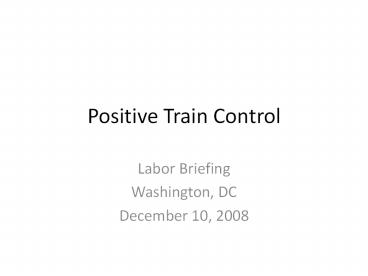Positive Train Control - PowerPoint PPT Presentation
1 / 20
Title: Positive Train Control
1
Positive Train Control
- Labor Briefing
- Washington, DC
- December 10, 2008
2
PTC Interoperability Objectives
- Meet Rail Safety Act requirements
- Train to train collisions
- Incursions of trains into established work zone
limits - Over-speed derailments
- Movement of a train through a switch in the wrong
position - Meet regulatory requirements for production
deployment - Railway Safety Program Plan (RSPP), Product
Safety Plan (PSP) - Support industry interoperability initiatives
- Telecomm, system behavior, human factors
3
Dark TerritoryTrack Warrant Control
Track Warrant Authority Limits
- Main Track Not Signaled
- Movement Authority Conveyed By Track Warrant or
Direct Traffic Control permit - 2. X Proceed From (Station or Location) To
(Station or Location) On Main Track
Spokane Subdivision - 8. X Hold Main Track At Last Named Point
- Train separation provided by train dispatcher
and train crew
4
Automatic Block System (ABS)Track Warrant Control
AMTK
Track Warrant Authority Limits
- Main Track Signaled for Movement in Both
Directions - Movement Authority Conveyed By Track Warrant or
Direct Traffic Control permit - 2. X Proceed From (Station or Location) To
(Station or Location) On Main Track
Spokane Subdivision - 8. X Hold Main Track At Last Named Point
- Train separation provided by train dispatcher,
train crew and signal system
5
Centralized Traffic Control (CTC)
Field Signal Indication
- One or More Main Tracks Signaled for Traffic in
Both Directions - Movement authority is conveyed by signal system
- Train dispatcher controls switches and signals
from distant location - Train separation provided by train crew and
signal system
6
Automatic Train Stop (ATS) Operation
- In Cab alarm sounds when train passes any signal
that is not green - Engineer has six (6) seconds to acknowledge ATS
alarm or the train brakes are applied - Once the acknowledgement is performed, there is
no further enforcement - Train separation provided by train crew and
signal system assisted by ATS alarms
7
Automatic Train Control (ATC) Operation
Field Signal Indication
CAB Signal Indication
- All wayside signal indications are displayed in
the locomotive cab - When locomotive passes a flashing yellow signal,
an alarm sounds and the engineer has six (6)
seconds to acknowledge or the brakes will be
applied. - The engineer then has seventy (70) seconds to
reduce to 20mph or less, or the brakes will be
applied. - Once the train is under 20mph no further
enforcement is applied - Train separation provided by train crew and
signal system assisted by speed control
8
Weaknesses of Existing Systems
- Systems are reactive as opposed to predictive
- Many systems wait for a violation to occur before
any form of enforcement is invoked (ATS and CCS) - Others use speed control to 20mph, then turn
operation over to the locomotive engineer (ATC) - Systems depend on human compliance
- Very time consuming to design and install
9
PTC System Overview
GPS
Data Link
Position Reference
Back OfficeServer (BOS)
PTC On Board Equipment Human-Machine
Interface Display Terminal On-Board Computer
Location Determination System Digital radio
(voice data)
Computer-Aided Dispatching
9
10
PTC System Overview
Track Database
Speed Restrictions
Work Zones
Train Consist
- Switches
- Work Zones
- Signals
Movement Authorities
Speed Restrictions
Warning Curve
Initialization
Braking Curve
Predictive Braking
10
11
On-Board Segment OverviewDisplay Graphic
Elements
12
On-Board Segment OverviewDisplay Energy
Management
13
GE C44ACCTE VTMS Display Prototype
13
14
Positive Train Control (PTC)Challenges
- Communications Spectrum
- Ensuring enough throughput for safe and efficient
movement of trains - Interoperability
- Communications
- System Behavior and Response
- On Board Display
- Predictive Enforcement Complexity
- Ensure safe braking calculations
15
Communications Spectrum
- Spectrum is like a highway -
- Radio channels are like lanes of the highway
- Too much traffic on a channel of Spectrum will
cause congestion - Congestion results in slower traffic and
sometimes collisions which destroys the Data
that travels on a lane - To reduce congestion, new sections of spectrum
(highway lanes) are needed so that the traffic
can spread out
16
Communications Spectrum, contd.
- The 220 spectrum was purchased by UP and NS to
support the expected data traffic from the
freight railroads. - Additional spectrum will be needed as more
railroads are added - Early projection for spectrum is 250 KHz (5
25KHz channel pairs) of 220 MHz spectrum - Spectrum demand study will commence soon
17
Interoperability
- Communications
- Standards that permit one railroads locomotive
to safely and efficiently operate over another
railroads infrastructure - UP, NS BNSF and CSX have agreed to interoperable
communications standards - The four Class 1 railroads have agreed to
locomotive display standards - Simplifies training and increases safety through
common operating standards - UP, NS, BNSF and CSX are using WABTEC for the on
board PTC system
18
Interoperability Scenario
Blaine
CANADA
BNSF Union Pacific UP BNSF both operate on
BNSF trackage
Seattle
Tacoma
Aberdeen
Centralia
WASHINGTON
Kelso
Vancouver
Pasco
Wishram
Portland
Hinkle
Oregon Trunk Jct
OREGON
19
What is the Interoperability Agreement?
- BNSF, CSX, NS and UP are signatories
- Agreement to implement technical standards for
- Locomotive to wayside communication
- Locomotive to back office communication
- Locomotive on board system behavior
- Locomotive on board displays
- Agreement for governance
- Working committee
- Steering committee
- Executive committee
- Agreement to manage 220 MHz spectrum
20
Predictive Enforcement Complexity
- Predictive braking algorithms (software) must
stop trains before authority violations with very
high degree of reliability - Algorithms must be smart enough to adapt to
changing conditions - Weather
- Train tonnage
- Different brake types of cars
- Weight distribution in train































